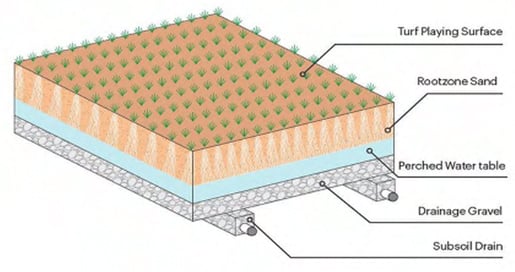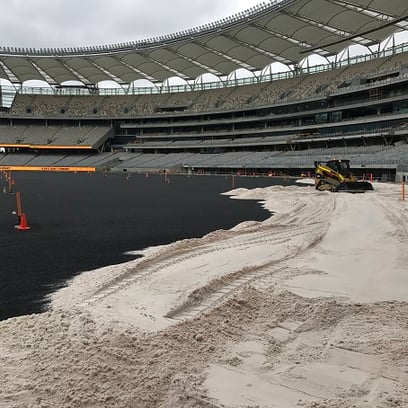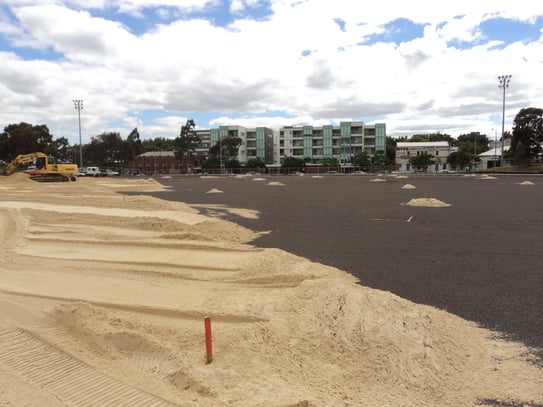What is a perched water table for a natural turf Field of Play?
In our previous blog post, we’ve explained why choosing the right rootzone sand profile is essential for your natural turf Field of Play.
A sand rootzone growing medium usually provides a high infiltration rate and will consist of either of the following:
- A Processed sand to meet a specification
- A Naturally occurring sand (i.e. dune or river sand)
The depth of the rootzone sand layer is generally not less than 250mm, depending on the relationship between moisture retention and infiltration of the material and is informed by the capillary fringe. The inclusion of a drainage gravel blanket beneath the rootzone sand layer facilitates the accumulation of water at the interface of the two material layers. This forms the capillary fringe and is known as a Perched Water Table (PWT) profile (refer to Figure 1 below).
 Figure 1 – Typical Perched Water Table Profile
Figure 1 – Typical Perched Water Table Profile
This means that water only passes through the PWT and into the drainage gravel when the sand layer exceeds field capacity. This establishes adequate head build-up within the profile at which time the excess water drains through.
In this article, we’ll study the technical aspects of this method, and we will review why opting for a perched water table solution is beneficial for your natural turf Field of Play.
What are the engineering principles of a PWT?
As shown in Figure 1 above, a perched water table is a layer of water that accumulates at the interface of two contrasting layers. In this case it is the sand and gravel layers in the sportsfield.
The engineering principles behind the specification of a PWT profile are as follows:
- Provision of a homogeneous rootzone sand layer with an adequate infiltration rate to accommodate high rainfall intensities.
- Provision of a gravel drainage layer to efficiently convey excess water to the drainage system.
- The sand and gravel are specified to create a ‘bridging’ effect and promote a perched water table at the interface of the gravel and the rootzone sand layer.
For ‘bridging’ to occur, the following relationship between the gravel and the rootzone sand particles is required:
- D15 (gravel) ≤ 8 x D85 (root zone).
Where:
- D15 (gravel) is the drainage gravel particle diameter below which 15% of the gravel particles (by weight) are smaller.
- D85 (root zone) is the rootzone sand particle diameter below which 85% of the rootzone sand particles (by weight) are smaller.
To maintain adequate permeability across the rootzone sand/drainage gravel interface and to encourage the perched water table to occur, the following relationship between the gravel and rootzone sand particles is required:
- D15 (gravel) ≥ 5 x D15 (root zone).
Where:
- D15 (gravel) is the drainage gravel particle diameter below which 15% of the gravel particles (by weight) are smaller.
- D15 (root zone) is the rootzone sand particle diameter below which 15% of the rootzone sand particles (by weight) are smaller.


Both photos show a PWT profile with sand over gravel
Why is it recommended to opt for a perched water table solution?
A perched water table solution brings various benefits to your natural turf Field of Play.
It can increase the water retention within the sand rootzone while providing a precise balance between water retention and aeration. It also encourages deep root growth, contributing to a resilient turf surface. Finally, its profile moisture content can be monitored via moisture probes to enable efficient irrigation application. This controlled irrigation helps to minimise irrigation loads and leads to drainage efficiency improvement.
To sum up, including a perched water table solution to your natural turf Field of Play profile is a relevant decision. For maximum efficiency, make sure that the PWT that you’re choosing fits perfectly with the other natural turf field of play elements selected. If done correctly, the PWT will help you improve your irrigation system and, coupled with the right rootzone sand profile, it will increase the overall performance of your Field of Play.
Feel free to reach us anytime is you have any questions on this topic. We’ll be more than happy to exchange and share knowledge on such an interesting topic!
